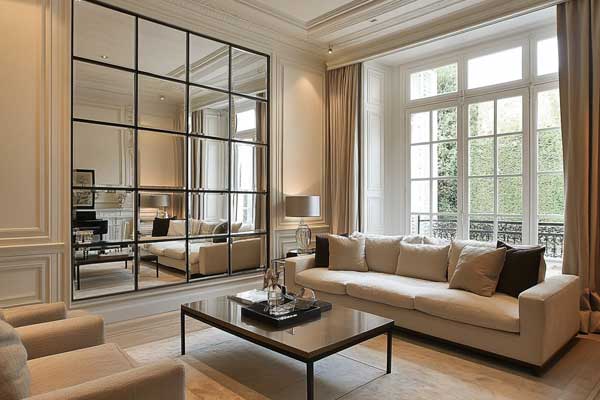Texture plays a crucial role in shaping how we perceive a space. Whether smooth, rough, glossy, or matte, textures interact with light and shadow to create visual depth. They can make a space feel larger, cozier, or more dynamic, depending on how they are applied. A well-thought-out use of texture can add sophistication and intrigue to any interior.
Optical illusions in interior design aren’t just about fun tricks—they are about manipulating perspective to enhance the aesthetic and functionality of a space. By using textures strategically, designers can alter the way a room is perceived, making ceilings seem taller, walls appear longer, or spaces feel more expansive.
Why Textures Matter More Than Color Alone
While color is a powerful design element, texture adds dimension and realism. A monochromatic room can feel rich and layered with the right textural interplay. Conversely, a space with bold colors but flat textures might feel uninspired. Texture brings a tactile quality that engages both sight and touch, creating a more immersive experience.
Visual Illusions and Texture

Our brains rely on visual cues to understand depth and dimension. When textures mimic natural shadows and highlights, they trick our eyes into perceiving surfaces differently. Raised surfaces appear closer, while recessed textures create the illusion of distance.
Light interacts with textures to create depth. A rough surface with pronounced shadows appears more dynamic than a smooth, glossy one. Strategic lighting can enhance these effects, amplifying the perceived structure of a space.
Repeating patterns, such as wavy lines or geometric designs, create a sense of movement, making walls or floors feel alive. These elements guide the eye through a space, directing attention to specific features and adding energy to an otherwise static environment.
Textures That Make Spaces Feel Larger
- Vertical Textures Make Ceilings Appear Higher. Vertical lines naturally draw the eye upward, elongating a space. Textured wallpapers, beadboard paneling, or tall shelving units reinforce this effect, making ceilings feel taller than they actually are.
- Horizontal Lines and Patterns. Horizontal elements create a visual stretch, making rooms feel wider. Textured wall treatments such as shiplap, subway tiles, or long wooden planks amplify this illusion by emphasizing lateral space.
- Light-reflective textures. Glossy and semi-gloss finishes reflect natural and artificial light, adding to the perception of openness. Metallic wallpapers, mirrored furniture, and lacquered surfaces can transform a dimly lit space into an airy retreat.
- Textures that mimic natural materials. Modern faux materials have reached a level where they convincingly replicate real marble and stone. These alternatives provide a sophisticated aesthetic without the weight or price tag of natural stone. Thin stone veneers, porcelain tiles, and engineered quartz offer the grandeur of polished stone while being easier to install and maintain. Faux marble works beautifully for countertops, backsplashes, and even statement walls, adding a touch of refined elegance without overwhelming a space.
- 3D Wall Textures. Geometric patterns create an interplay of light and shadow, adding a three-dimensional feel to flat surfaces. Raised wall panels provide an actual tactile experience, while printed patterns offer a more budget-friendly alternative that still tricks the eye. High-contrast color combinations in geometric patterns enhance the perception of depth, making walls appear more sculptural.
- Flooring Textures. Rugs with swirling or wavy designs can make a floor feel like it’s undulating, adding a playful yet sophisticated element. High-pile rugs introduce softness and warmth, whereas low-pile rugs allow for sharp, defined textures that reinforce structure.
- Ceiling Textures. Layering moldings and recessed panels creates a sophisticated play of light and shadow, making ceilings feel more expansive. Mirrored ceilings and metallic finishes bounce light around a room, adding to a sense of grandeur and openness.
- Faux Materials. Brick veneer and lightweight stone panels add texture without the bulk, providing an old-world charm in a modern setting. Venetian plaster and stucco offer a soft, textural quality that elevates walls without the need for extensive remodeling.
Lighting and Texture: The Perfect Pairing for Visual Tricks
Proper lighting can make textures appear more pronounced or subdued. Wall-mounted sconces can highlight an embossed wallpaper pattern, while directional spotlights can emphasize the contours of a 3D wall panel. Understanding how light interacts with texture allows for greater control over visual depth.
Layered lighting—combining ambient, task, and accent lighting—enhances the perception of texture by adding depth and contrast. A well-lit space with varied light sources will appear richer and more dimensional than one with flat, uniform lighting.
Textures in Furniture and Decor That Trick the Eye
Furniture that combines different materials—such as wood, metal, glass, and upholstery—adds complexity and intrigue. The interplay between smooth and rough textures creates a sense of depth that enhances the visual interest of a space.
Three-dimensional art pieces, layered shelving, and sculptural light fixtures introduce dynamic elements that interact with light and shadow. These details draw the eye and contribute to the overall illusion of movement within a space.
Conclusion
Textures have the ability to completely transform a space, offering depth, intrigue, and illusion. Whether through the clever use of reflective materials, faux natural textures, or three-dimensional patterns, the right textures can make a home feel larger, cozier, or more luxurious. When paired with thoughtful lighting and color schemes, these textures go beyond aesthetics, actively influencing how we experience and interact with our surroundings. Designing with texture is not just about what we see—it’s about how we feel, creating an environment that is as engaging to the touch as it is to the eye.




